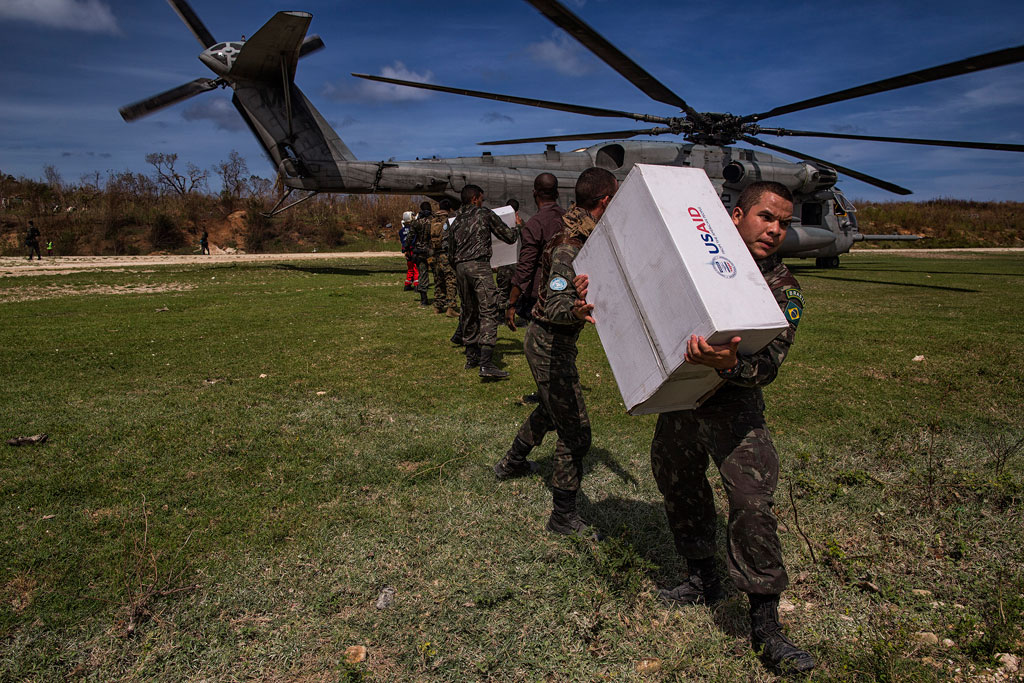
While Haiti is still counting its dead and assessing the damage in the aftermath of Hurricane Matthew, the powerful Category 4 storm that battered the tiny island nation last week, a senior United Nations peacekeeping official today reported that significant headway is being made clearing the roads to make facilitate the movement of humanitarian aid.
“As soon as the hurricane moved on, one of the first assessments we made was the very poor state of the roads – which were never fantastic to begin with – and we focused on opening [them] up to allow aid to reach the population,” Mourad Wahba, Deputy Special Representative for the UN Stabilization Mission in Haiti (MINUSTAH) told reporters in New York via videoconference from the capital, Port-au-Prince.
He said that thanks to the efforts of MINUSTAH engineers and local authorities, the roads have been cleared and there is now access from the Port-au-Prince, the site of the country’s airport and where most of the aid is offloaded, all the way to areas in the southwest of the country, including Les Cayes and Jérémie, where the hurricane made landfall on 4 October.
“From Les Cayes we have opened the roads to Jérémie; and from Le Cayes we are also opening the roads […] up along the western coast of Haiti. But what remains [is to clear] secondary roads, where quite a few people are in need of support, and its urgent that we continue moving there,” said Mr. Wahba.
As such, MINUSTAH significantly boosted its engineering capacity in Les Cayes and Jérémie, and is also providing security for humanitarian convoys, he said, emphasizing: “As you can imagine, populations along some of the routes that have not been reached are angry, they are looking for food, and we need to ensure that [this relief] is secure so that it gets to its destination.”
On related issues, he said the Mission is reviewing police stations, while also distributing water purification systems to limit the spread of diseases. Yesterday, a convoy of 26 trucks left Port-au-Prince with non-food items and the same number of trucks left today with food and non-food supplies along with a massive water purification system donated by the French Government. “All this requires access and it requires security,” he reiterated.
Mr. Wahba went on to say that the UN Office for the Coordination of Humanitarian Affairs (OCHA) is coordinating the work of a number of UN agencies on the ground in Haiti. In addition, non-governmental organizations (NGOs) are using Le Cayes and Jérémie as the bases from which they are working to reach hard-hit areas, and MINUSTAH is trying to facilitate that access.
“We should pay tribute to the capacities of the local authorities in Haiti,” he noted, as they have been pushing preventive action, wishing to be more involved than they had been in the wake of the 2010 earthquake. Indeed, he said, the decision by local authorities to evacuate some populations had saved lives.
Responding to questions, Mr. Wahba said that at last count, the storm had left some 473 people dead in its wake, “but the central emergency authorities are working to identify every death [and] I believe this will rise, but I believe it will be in the hundreds, not the thousands.”
“The Government is very conscious of the confusion – much of it motivated by extremely good intentions – in the aftermath of the 2010 earthquake,” he said, and with that in mind, the authorities are trying to centralize all requests in Port-au-Prince and to have two coordination hubs – Le Cay and Jérémie – where offers of support, requests for transport and various sector needs are assessed.
As for preparations ahead of the hurricane, he said the UN and MINUSTAH had been working with the national authorities to develop the disaster risk management system and, “to the extent that we do have an emergency response centre, that is due to the work of the UN and international cooperation in general.”
Before the hurricane, UN assessment teams had been deployed to help the government put its preparedness system and its emergency communications system in place. He said the UN had also worked to prep-position stocks in the region, including food items, tarpaulins, hygiene kits and water purifications tablets.
“There are perhaps some 175,000 people are today in shelters,” he stated, responding to another question, but noted that there are also many people who have not left their homes though the structures themselves were destroyed in the storm. Tarps, household equipment and hygiene kits are being made available for those who did not want to leave their homes, he added.
As a result of the hurricane, septic trenches had been flooded, leading to focal contamination of clean water sources. “There wasn’t much in the way of available clean drinking water in many of these areas, but now even that has been contaminated and there are hundreds of cases of diarrheal diseases,” explained Mr. Wahba.
“Some of these are cholera and some are not, but because of the lack of [our] presence in the field, we are not sure,” he said, but added that perhaps 500 cases of diarrheal disease had been treated. “This is why we are rushing in chlorination kits as a priority, and we have just received the news of one million cholera vaccines that will be deployed to these areas soon,” he stressed.